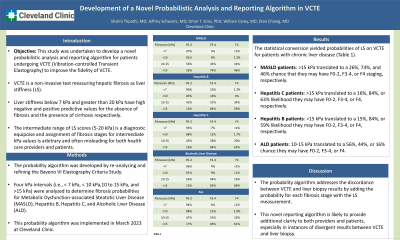Tuesday Poster Session
Category: Liver
P4598 - Development of a Novel Probabilistic Analysis and Reporting Algorithm in VCTE
Tuesday, October 29, 2024
10:30 AM - 4:00 PM ET
Location: Exhibit Hall E

Has Audio

Shalini Tripathi, MD
Cleveland Clinic
Shaker Heights, OH
Presenting Author(s)
Shalini Tripathi, MD1, Jeffrey Schwartz, MD1, Omar T. Sims, PhD2, William Carey, MD2, Dian Chiang, MD3
1Cleveland Clinic, Shaker Heights, OH; 2Cleveland Clinic, Cleveland, OH; 3Digestive Disease Institute, Cleveland Clinic, Moreland Hills, OH
Introduction: Vibration-controlled Transient Elastography (VCTE) is a non-invasive test measuring hepatic fibrosis as liver stiffness (LS). Liver stiffness below 7 kPa and greater than 20 kPa have high negative and positive predictive values for the absence of fibrosis and the presence of cirrhosis respectively. The intermediate range of LS scores (5-20 kPa) is a diagnostic equipoise and assignment of fibrosis stages for intermediate kPa values is arbitrary and often misleading for both health care providers and patients. This study was undertaken to develop a novel probabilistic analysis and reporting algorithm for patients undergoing VCTE to improve the fidelity of VCTE.
Methods: The probability algorithm was developed by re-analyzing and refining the Baveno VI Elastography Criteria Study. A total of 5648 patients with liver biopsies and VCTE within 6 months were reviewed. Four kPa intervals (i.e., < 7 kPa, < 10 kPa,10 to 15 kPa, and >15 kPa) were analyzed to determine fibrosis probabilities for Metabolic Dysfunction-associated Steatotic Liver Disease (MASLD), Hepatitis B, Hepatitis C, and Alcoholic Liver Disease (ALD). This probability algorithm was implemented in March 2023 at Cleveland Clinic.
Results: The statistical conversion yielded probabilities of LS on VCTE for patients with the four most common etiology of chronic liver diseases. For MASLD patients, >15 kPa translates to a 26%, 74%, and 46% chance that they may have F0-2, F3-4, or F4 staging, respectively. For Hepatitis C patients, >15 kPa translates to a 16%, 84%, or 63% likelihood they may have F0-2, F3-4, or F4, respectively. For Hepatitis B patients, >15 kPa translates to a 15%, 84%, or 59% likelihood they may have F0-2, F3-4, or F4, respectively. For ALD patients, 10-15 kPa translates to a 56%, 44%, or 16% chance they may have F0-2, F3-4, or F4. Other probabilities stratified by kPa and fibrosis etiology can be found in Table 1.
Discussion: The probability algorithm addresses the discordance between VCTE and liver biopsy results by adding the probability for each fibrosis stage with the LS measurement. This novel reporting algorithm is likely to provide additional clarity to both providers and patients, especially in instances of divergent results between VCTE and liver biopsy.
Note: The table for this abstract can be viewed in the ePoster Gallery section of the ACG 2024 ePoster Site or in The American Journal of Gastroenterology's abstract supplement issue, both of which will be available starting October 27, 2024.
Disclosures:
Shalini Tripathi, MD1, Jeffrey Schwartz, MD1, Omar T. Sims, PhD2, William Carey, MD2, Dian Chiang, MD3. P4598 - Development of a Novel Probabilistic Analysis and Reporting Algorithm in VCTE, ACG 2024 Annual Scientific Meeting Abstracts. Philadelphia, PA: American College of Gastroenterology.
1Cleveland Clinic, Shaker Heights, OH; 2Cleveland Clinic, Cleveland, OH; 3Digestive Disease Institute, Cleveland Clinic, Moreland Hills, OH
Introduction: Vibration-controlled Transient Elastography (VCTE) is a non-invasive test measuring hepatic fibrosis as liver stiffness (LS). Liver stiffness below 7 kPa and greater than 20 kPa have high negative and positive predictive values for the absence of fibrosis and the presence of cirrhosis respectively. The intermediate range of LS scores (5-20 kPa) is a diagnostic equipoise and assignment of fibrosis stages for intermediate kPa values is arbitrary and often misleading for both health care providers and patients. This study was undertaken to develop a novel probabilistic analysis and reporting algorithm for patients undergoing VCTE to improve the fidelity of VCTE.
Methods: The probability algorithm was developed by re-analyzing and refining the Baveno VI Elastography Criteria Study. A total of 5648 patients with liver biopsies and VCTE within 6 months were reviewed. Four kPa intervals (i.e., < 7 kPa, < 10 kPa,10 to 15 kPa, and >15 kPa) were analyzed to determine fibrosis probabilities for Metabolic Dysfunction-associated Steatotic Liver Disease (MASLD), Hepatitis B, Hepatitis C, and Alcoholic Liver Disease (ALD). This probability algorithm was implemented in March 2023 at Cleveland Clinic.
Results: The statistical conversion yielded probabilities of LS on VCTE for patients with the four most common etiology of chronic liver diseases. For MASLD patients, >15 kPa translates to a 26%, 74%, and 46% chance that they may have F0-2, F3-4, or F4 staging, respectively. For Hepatitis C patients, >15 kPa translates to a 16%, 84%, or 63% likelihood they may have F0-2, F3-4, or F4, respectively. For Hepatitis B patients, >15 kPa translates to a 15%, 84%, or 59% likelihood they may have F0-2, F3-4, or F4, respectively. For ALD patients, 10-15 kPa translates to a 56%, 44%, or 16% chance they may have F0-2, F3-4, or F4. Other probabilities stratified by kPa and fibrosis etiology can be found in Table 1.
Discussion: The probability algorithm addresses the discordance between VCTE and liver biopsy results by adding the probability for each fibrosis stage with the LS measurement. This novel reporting algorithm is likely to provide additional clarity to both providers and patients, especially in instances of divergent results between VCTE and liver biopsy.
Note: The table for this abstract can be viewed in the ePoster Gallery section of the ACG 2024 ePoster Site or in The American Journal of Gastroenterology's abstract supplement issue, both of which will be available starting October 27, 2024.
Disclosures:
Shalini Tripathi indicated no relevant financial relationships.
Jeffrey Schwartz indicated no relevant financial relationships.
Omar Sims indicated no relevant financial relationships.
William Carey indicated no relevant financial relationships.
Dian Chiang: Ipsen – Advisory Committee/Board Member.
Shalini Tripathi, MD1, Jeffrey Schwartz, MD1, Omar T. Sims, PhD2, William Carey, MD2, Dian Chiang, MD3. P4598 - Development of a Novel Probabilistic Analysis and Reporting Algorithm in VCTE, ACG 2024 Annual Scientific Meeting Abstracts. Philadelphia, PA: American College of Gastroenterology.
